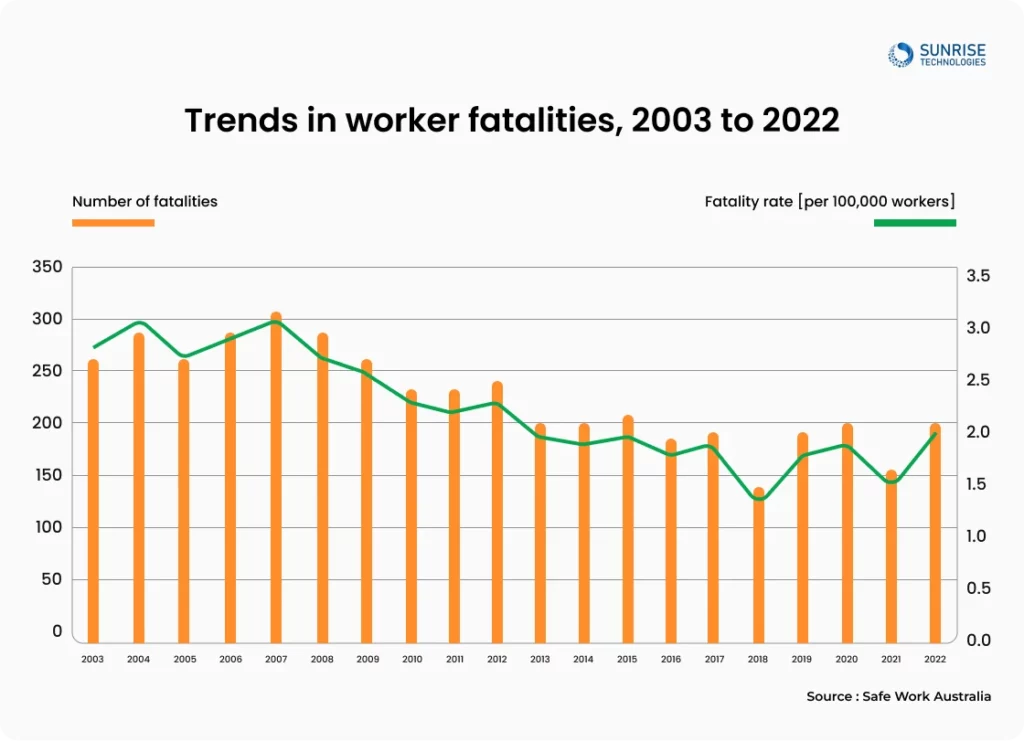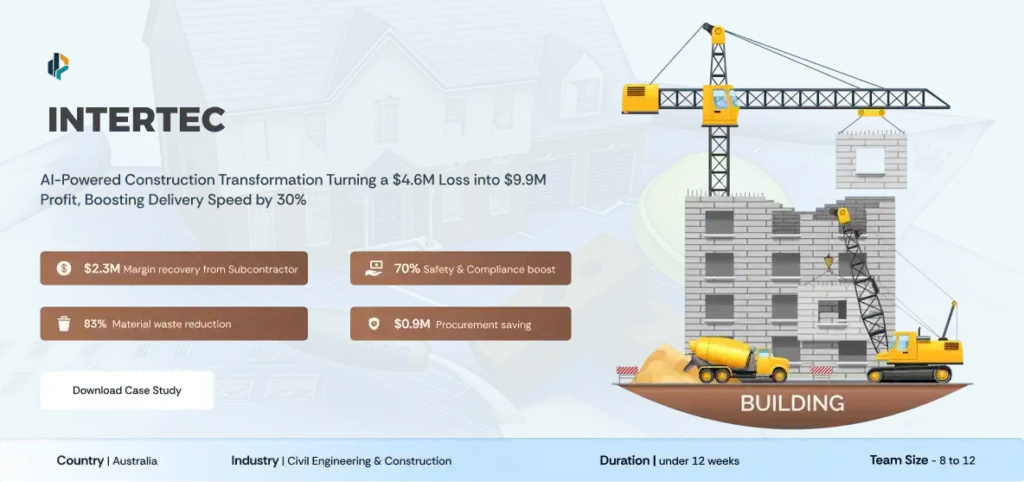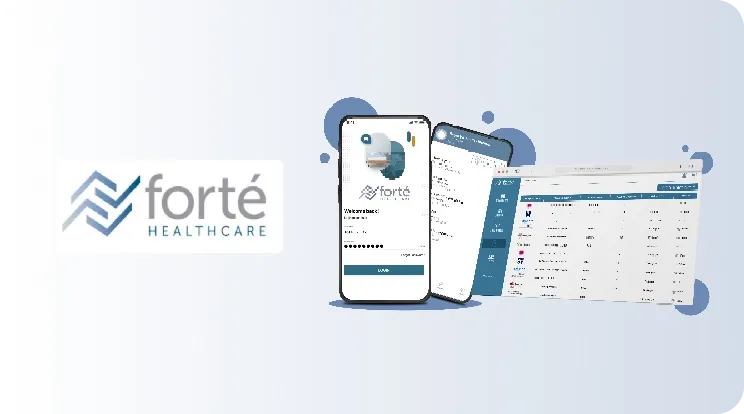
Top 10 ways to improve workplace safety at construction sites
Mar 17, 2025
Construction sites can be very dangerous places. In fact, construction workers often get hurt or even die while working. Based on the findings from the Safe Work Australia report, it is revealed that the majority of the 100+ annual fatalities in Australia occur predominantly in New South Wales (27%), followed closely by Victoria (25%) and Queensland (20%).

As construction work continues to grow, it’s very important for contractors, site managers, and workers to always keep safety as the top priority. By understanding the risks and taking steps to prevent accidents, we can make construction sites much safer for everyone.
In this article, we’ll talk about the biggest safety problems at construction sites and give easy tips to help fix these problems. By following these tips, we can work towards a safer future for the hardworking people who build our world.
10 Tips for Workplace Safety

1. Keep walkways clear and well-lit:
Ensuring that pathways are free from clutter and well illuminated can help prevent accidents and make it easier for workers to move around safely. Regularly clearing debris, tools, and materials from walkways not only reduces tripping hazards but also allows for unobstructed movement.
Proper lighting, both natural and artificial, enhances visibility, enabling workers to navigate the site safely, even in low-light conditions.
2. Provide proper training for all workers:
Offering thorough training to all employees on safety procedures and equipment usage is essential for creating a secure work environment. Regular training sessions should cover a wide range of topics, including personal protective equipment (PPE) usage, hazard identification, emergency response, and safe operating procedures for machinery and tools.
By investing in worker training, construction companies demonstrate their commitment to safety and empower their employees to make informed decisions on the job.
3. Use safety equipment at all times:
Wearing the necessary safety gear, such as helmets, gloves, and goggles, is crucial to protect workers from potential hazards on the construction site. Properly fitted safety equipment acts as a shield against various risks, safeguarding workers from head injuries, hand injuries, and eye injuries. By consistently wearing safety gear, workers create a barrier between themselves and potential dangers, reducing the likelihood of accidents and injuries.
Safety equipment should be inspected regularly to ensure it is in good condition and replaced when damaged or worn out.
4. Regularly inspect tools and machinery:
Conducting routine checks on tools and machinery helps identify any issues early on, reducing the risk of accidents due to equipment malfunctions. Regular inspections involve a thorough examination of all components, including moving parts, electrical systems, and safety features, to ensure they are functioning properly.
This proactive approach allows for the timely detection and resolution of potential problems before they escalate into larger issues or cause accidents. Maintenance schedules should be established for each piece of equipment, outlining the frequency and scope of inspections.
5. Encourage open communication about safety concerns:
Creating a culture where workers feel comfortable discussing safety issues openly can lead to the early identification and resolution of potential hazards. Open communication fosters a sense of shared responsibility for safety, empowering workers to voice their concerns without fear of repercussions. Regular safety meetings, toolbox talks, and one-on-one discussions provide platforms for workers to raise issues, share ideas, and collaborate on solutions.
By actively listening to worker feedback and addressing concerns promptly, construction managers demonstrate their commitment to safety and build trust within the team. An open communication environment also allows for the sharing of best practices and lessons learned, promoting continuous improvement in safety standards.
6. Implement regular safety meetings:
Holding frequent safety meetings allows for the discussion of safety protocols, updates, and concerns, keeping everyone informed and aware of best practices. Regular safety meetings serve as a platform for sharing important safety information, such as new procedures, hazard alerts, and emergency protocols. These meetings provide an opportunity for workers to ask questions, seek clarification, and raise any safety concerns they may have.
By gathering regularly to discuss safety topics, construction teams can reinforce a culture of safety awareness and ensure that everyone is up to date on the latest safety guidelines. Safety meetings also offer a forum for collaboration and feedback, enabling workers to contribute their insights and experiences to enhance overall safety practices on the construction site.
7. Ensure proper signage for hazards:
Clearly marking hazardous areas with appropriate signage helps alert workers to potential dangers, reducing the likelihood of accidents. Visible and easily understandable signs serve as visual cues that draw attention to specific hazards, such as slippery floors, overhead hazards, or restricted zones.
By strategically placing signage in high-risk areas, construction sites can effectively communicate safety information to workers and visitors. Proper signage not only warns individuals of potential dangers but also reminds them to take necessary precautions to avoid accidents.
Regularly reviewing and updating signage ensures that safety information remains current and relevant, enhancing overall hazard awareness on the construction site.
8. Maintain a clean and organized work area:
Keeping the construction site tidy and organized not only improves efficiency but also minimizes the risk of trips, slips, and falls. A clean and organized work area reduces clutter and obstacles that can cause accidents, ensuring a safer environment for workers. By regularly cleaning up debris, materials, and equipment, construction sites become more navigable and less prone to hazards.
Organizing tools and materials in designated storage areas enhances workflow efficiency and prevents potential tripping hazards. Maintaining cleanliness also promotes a professional image and instills a culture of safety consciousness among workers. By prioritizing a clean and organized work area, construction teams create a safer and more productive workspace, reducing the likelihood of accidents and injuries.
9. Monitor weather conditions for outdoor work:
Staying informed about weather forecasts is crucial for planning outdoor work activities safely and avoiding weather-related accidents. Construction sites, particularly those with outdoor components, are susceptible to various weather conditions that can impact worker safety.
By closely monitoring weather forecasts and alerts, construction managers can make informed decisions about work schedules, equipment usage, and necessary safety precautions. Anticipating potential weather hazards, such as heavy rain, high winds, or extreme temperatures, allows teams to prepare accordingly and implement appropriate safety measures. This may include postponing certain tasks, providing adequate shelter or shade, or ensuring workers have access to necessary protective gear.
10. Have a clear emergency response plan in place:
Establishing a well-defined emergency plan ensures that all workers know what to do in case of an accident or emergency, promoting a swift and coordinated response. An effective emergency response plan outlines specific procedures and protocols to follow in various emergency scenarios, such as injuries, fires, or natural disasters.
By clearly communicating these protocols to all team members and conducting regular drills, construction sites can ensure that everyone is prepared to respond quickly and effectively in times of crisis. Designating emergency exits, assembly points, and emergency contacts further enhances the readiness of the workforce to handle emergencies.
Enhance Workplace Safety with Advanced Construction Management Software
Construction management software is an automated software solution that provides ease and efficiency during the construction process, from planning through to execution. This software allows construction managers and contractors to coordinate various jobs obligations, monitor progress, manage available resources, and assure safety compliance-all in one platform.
In addition to this, essential tools such as project scheduling, safety reporting, real-time communication, document management, and risk assessment are integrated to improve efficiency and limit delays. By providing cloud-hosted or locally-installed solutions, construction firms achieve enhanced collaboration and cost control and a safer working environment on the construction sites.
Here Are the Key Features of Our Best Construction Management Software to Improve Workplace Safety

1. Real-Time Tracking and Monitoring
Our construction safety inspection app’s real-time tracking capabilities allow managers to monitor worker locations and movements, enabling them to identify potential hazards and intervene promptly. This feature helps prevent accidents and ensures that workers adhere to safety protocols at all times.
2. Hazard Identification and Reporting
Our app for construction workers provides workers with easy access to hazard reporting tools, empowering them to identify and report safety concerns directly from the field. This streamlined process enables quick resolution of issues, reducing the likelihood of incidents.
3. Safety Training and Certification Management
This software offers a comprehensive solution for managing worker safety training and certifications. Managers can easily track expiration dates, schedule refresher courses, and ensure that all workers are properly trained and equipped to handle their tasks safely.
4. Incident Reporting and Investigation
In the event of an accident or near-miss, our construction work order software provides a user-friendly platform for incident reporting and investigation. This feature allows for thorough documentation, root cause analysis, and implementation of corrective actions to prevent similar occurrences in the future.
5. Emergency Response Planning
The software includes tools for developing and communicating emergency response plans, ensuring that all workers are aware of the necessary protocols in case of an emergency. Regular drills and updates help maintain preparedness and improve response times.
6. Safety Analytics and Reporting
Our construction safety inspection app’s advanced analytics and reporting capabilities provide valuable insights into safety performance. Managers can track key metrics, identify trends, and make data-driven decisions to enhance safety practices and reduce incidents over time.
7. Toolbox Talks and Safety Meetings
The software facilitates the scheduling and documentation of toolbox talks and safety meetings, ensuring that important safety information is regularly communicated to all workers. This feature helps reinforce safety protocols and promotes a culture of safety awareness.
8. Personal Protective Equipment (PPE) Management
This software offers a comprehensive solution for managing PPE, including tracking inventory, monitoring expiration dates, and ensuring that workers have access to the necessary protective equipment. This feature helps maintain compliance with safety regulations and reduces the risk of injuries.
9. Job Hazard Analysis (JHA) and Job Safety Analysis (JSA)
The software provides tools for conducting JHAs and JSAs, enabling managers to identify potential hazards associated with specific tasks and implement appropriate control measures. This proactive approach helps mitigate risks before work begins.
10. Permit to Work System
Building construction work program schedule software permit to work system ensures that workers are authorized to perform specific tasks and have the necessary training and equipment. This feature helps prevent unauthorized access to hazardous areas and reduces the risk of accidents.
11. Contractor Management
The software includes tools for managing contractor safety, including pre-qualification, safety performance tracking, and communication of site-specific safety requirements. This feature helps ensure that all workers, including contractors, adhere to the same safety standards.
12. Mobile Accessibility
Our software offers mobile accessibility, allowing workers to access safety information, report hazards, and communicate with managers directly from their smartphones or tablets. This feature enhances the efficiency and effectiveness of safety management on the job site.
By leveraging these powerful features in our software, construction companies can create a culture of safety, empower workers to take an active role in maintaining a secure work environment, and ultimately reduce the risk of accidents and injuries on the job site.
Real-World Impact: Intertec’s AI-Powered Safety Turnaround

Intertec, a $73M construction firm operating across NSW, QLD, and VIC, struggled with operational inefficiencies and safety non-compliance—resulting in a staggering $4.6M net loss in 2023. To address this, Sunrise Technologies deployed a mobile-first, AI-enabled Safety Management System empowering on-site teams to manage Safety Work Method Statement (SWMS) forms digitally and receive real-time hazard alerts via video and sensor analytics.
Key Outcomes:
- 70% reduction in safety-related losses
- Saved $3.2M annually by avoiding stoppages and compliance breaches
- AI hazard detection boosted site compliance and incident response
- Streamlined safety documentation improved audit readiness and lowered risk
Intertec’s transformation shows how AI-driven safety workflows don’t just reduce accidents—they reshape operations and drive profitability.
Why Choose Our Construction Management Software?
Choosing our construction management software is a strategic decision that can significantly enhance your project’s safety, efficiency, and profitability. Our cutting-edge platform is designed by industry experts to streamline safety processes, improve communication, and provide real-time insights into your project’s performance.
With features like hazard identification, incident reporting, and safety analytics, our software empowers you to proactively manage risks and create a culture of safety on your job site.
By investing in our construction management software, you’ll gain a competitive edge, reduce costs associated with accidents and delays, and deliver projects with the highest standards of quality and safety.
In conclusion, enhancing workplace safety at construction sites is a paramount priority that requires a multifaceted approach. By implementing key strategies such as regular safety training, hazard identification, clear communication channels, and proactive safety measures, construction companies can create a culture of safety awareness and responsibility among workers. Utilizing technology such as construction management software, real-time tracking, and safety analytics further strengthens safety protocols and enables timely responses to potential risks.
Sam is a chartered professional engineer with over 15 years of extensive experience in the software technology space. Over the years, Sam has held the position of Chief Technology Consultant for tech companies both in Australia and abroad before establishing his own software consulting firm in Sydney, Australia. In his current role, he manages a large team of developers and engineers across Australia and internationally, dedicated to delivering the best in software technology.






Cloud Based Project Management Platform
Read the challenges we faced and how we helped
View Case Study













